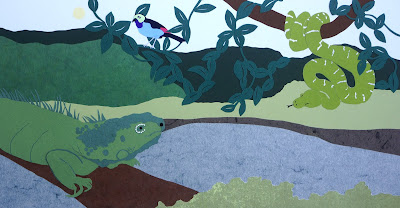 |
| Banner displaying participating authors' books welcomed families to the Bedtime Story Jam |
Last Friday evening the children of Westwood Charter Elementary in Los Angeles, California, came to school dressed in their pajamas ready to listen to stories from me and nine other children’s book authors as part of the school's annual Bedtime Story Jam. The goal of the event is promoting literacy and inspiring young story tellers and writers. In between sessions the children ate milk and cookies and browsed for books at the book fair in the library.
 |
| My presentation of Butterflies in Room 6 was in Room 4 |
This was my third time to participate in this fun celebration of reading. I had two groups of very enthusiastic children and their parents in my room. I showed slides, read my book
Butterflies in Room 6, shared my butterfly growing supplies and samples of butterfly eggs and chrysalises, and signed books.
 |
| My butterfly habitat, caterpillar container, and samples showing butterfly development |
I thank Shelby, my volunteer room host, for helping me to set up, introducing me, and for making sure that everything ran smoothly. Shelby’s aunt, who I have known for many years at the library at Palms Middle School, was also there and it was great to catch up on library news.
 |
| A young helper is demonstrating my Monarch Butterfly hand puppet. |
I also thank Angie Rowe and Patricia Maynard and the Bedtime Story Jam committee for inviting me and organizing this festive event. Afterward they sponsored a reception on the library patio for the authors-- a wonderful chance to relax, chat with other authors and enjoy delicious food. And I thank Mrs. Nelson’s Book Fair Company for supplying my books for the event. I was pleased to see that so many had already been purchased by the night of the Story Jam.
 |
| Bedtime Story Jam banner |
During the course of the evening I saw several families I knew and enjoyed meeting many other students and parents. Westwood Charter is one of my neighborhood schools and it is always a pleasure to be part of a local event.













